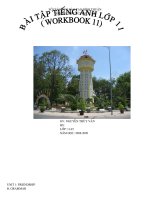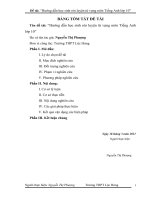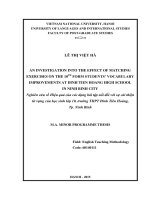Unit 1 vocabulary and reading tu vung va doc hieu lớp 10
Bạn đang xem bản rút gọn của tài liệu. Xem và tải ngay bản đầy đủ của tài liệu tại đây (521.64 KB, 4 trang )
Khóa học TIẾNG ANH 10 – Cô Phan Điệu
www.facebook.com/cophandieu
UNIT 1: A DAY IN THE LIFE OF…
BÀI 1: VOCABULARY AND READING
VIDEO BÀI GIẢNG và LỜI GIẢI CHI TIẾT CÁC BÀI TẬP chỉ có tại website MOON.VN
A. Reading:
Trước khi đi vào bài đọc, các em cùng cô trả lời các câu hỏi về công việc thường ngày của các em nhé.
- What time do you often get up?
- What time you have breakfast?
- What time do you go to school?
- What do you often do in the morning?
- What you often do in the afternoon
- What time do you go to bed?
Tiếp theo, chúng ta cùng xem 1 đoạn văn về daily rountine của chú Vỹ và cô Tuyết và trả lời các câu hỏi
sau nhé.
Mr. Vy: The alarm goes off at 4:30. I get up and go down to the kitchen to boil some water for my
morning tea. I drink several cups of tea, have a quick breakfast and then lead the buffalo to the field. It
takes me 45 minutes to get ready. I leave the house at a quarter past five and arrive in the field at exactly
5:30. I plough and harrow my plot of land and at a quarter to eight I take a short rest. During my break I
often drink tea with my fellow peasants and smoke local tobacco. I continue to work from a quarter past
eight till 10:30. Then I go home, take a short rest and have lunch with my family at 11:30. After lunch I
usually take an hour’s rest.
Mrs. Tuyet: At 2:30 in the afternoon we go to the field again. We repair the banks of our plot of land.
Then my husband pumps water into it while I do the transplanting. We work for about two hours before
we take a rest. We finish our work at 6 p.m. We have dinner at about 7 p.m, then we watch TV and go to
bed at about 10 p.m. Sometimes we go and see our neighbours for a cup of tea. We chat about our work,
our children and our plans for the next crop. Although it’s a long day for us, we are contented with what
we do. We love working and we love our children.
Từ vựng xuất hiện trong bài:
1. To go off = to ring: reo, rung
2. To get ready = to prepare: chuẩn bị
3. To plough: cày ruộng
4. To harrow: bừa ruộng
5. A plot of land: mảnh đất
6. Take a shore break/rest: nghỉ 1 chút
7. Fellow peasants: những người nông dân làm cùng, gần ruộng nhau
8. Local tobacco: thuốc lá của 1 khu vực, địa phương tự làm
9. To plump st into: bơm cái gì vào cái gì (nước)
10. Do the transplanting: cấy lúa, trồng cây
11. Be contented with st: hài lòng với cái gì
Pro S.A.T – Giải pháp toàn diện cho kì thi THPTQG
MOON.VN – Học để khẳng định mình
Khóa học TIẾNG ANH 10 – Cô Phan Điệu
www.facebook.com/cophandieu
Task 1. Choose the option A, B, or C that best suits the meaning of the italicized word(s).
1. The alarm goes off at 4:30.
A. goes wrong be
B. goes away
C. rings
2. It takes me 45 minutes to get ready.
A. to go
B. to wake up
C. to prepare
3. We chat about our work.
A. talk in a friendly way
B. learn
C. discuss
4. We are contented with what we do.
A. satisfied with
B. disappointed with
C. worried about
Đây là bài tập tìm từ đồng nghĩa với từ gạch chân trong câu, một dạng câu hỏi rất quen thuộc trong kì thì
THPT Quốc Gia nên các em chú ý thật kĩ nhé. Đối với dạng câu hỏi này, có thể các em sẽ may mắn gặp
những từ mà các em đã biết và nhanh chóng đưa ra đáp án chính xác. Tuy nhiên, nếu như các em gặp các
từ hoàn toàn mới hoặc các từ có nghĩa hơi giống nhau thì sao nhỉ? Nếu như vậy thì các em phải hết sức
bình tĩnh, tỉnh táo và áp dụng mẹo sau của cô nhé.
1. Nếu như từ gạch chân là hoàn toàn mới với các em, hãy dựa vào các từ xung quanh của câu và kết
hợp với kiến thức của bản than để suy luận nghĩa của từ.
Ví dụ:
I think we have to solve this problem once and for all.
A. forever
B. for goods
C. temporarily
D. in the end
“Tôi nghĩ chúng ta cần phải giải quyết vấn đề này …”
Once: một + for all: cho tất cả => mãi mãi
2. Nếu như các em không thể sử dụng phương pháp 1 để suy luận nghĩa của từ đó thì hãy trực tiếp
thay thế các phương án đã cho lên phần gạch chân, thấy cái nào logic nhất thì chọn.
Ví dụ: Did anyone acknowledge responsibility for the outbreak of the fire?
A. admit
B. report
C. find out
D. talk about
Từ “acknowledge” có vẻ khá mới mẻ với các em nhưng các đáp án thì lại là những từ quen thuộc. Hãy lần
lượt thay thế các đáp án vào câu và xem đâu là câu logic nhất nhé.
Đáp án: A. admit: “Đã có ai nhận trách nhiệm cho vụ hỏa hoạn chưa?”
Bây giờ, chúng ta cùng làm Task 1 nhé:
1. The alarm goes off at 4:30.
A. goes wrong be
B. goes away
C. rings
Dựa vào từ “alarm” (đồng hồ báo thức) thì sẽ phải “rung” = ring. => goes off = rings: rung, reo.
2. It takes me 45 minutes to get ready.
A. to go
B. to wake up
C. to prepare
Get ready: ready là sẵn sàng => có thể suy luận: get ready có nghĩa là chuẩn bị = C. to prepare
3. We chat about our work.
A. talk in a friendly way
B. learn
C. discuss
Chat: tán gẫu = talk in a friendly way
4. We are contented with what we do.
A. satisfied with
B. disappointed with
C. worried about
“Although it’s a long day for us, we are contented with what we do.” => “Mặc dù đó là một ngày làm
việc dài đối với chúng tôi, nhưng chúng tôi … với cái mình làm” => 2 ý đối lập nhau thì không thể là B.
disappointed with (thất vọng) và C. worried about (lo lắng) được. Đáp án. A satisfied with (hài long) là
hợp lý nhất.
Pro S.A.T – Giải pháp toàn diện cho kì thi THPTQG
MOON.VN – Học để khẳng định mình
Khóa học TIẾNG ANH 10 – Cô Phan Điệu
www.facebook.com/cophandieu
Bài tập tiếp theo là bài tìm câu trả lời cho các câu hỏi liên quan đến bài khóa.
Task 2: Give the correct answers for the following questions.
1. What is Mr. Vy’s occupation?
2. What time does he get up and what does he do after that?
3. What does he do in the morning?
4. What do Mr. Vy and his wife do in the afternoon?
5. Are they happy with their lives or not? Why?
Đối với dạng bài này, các em lưu ý, Skim bài khóa trước, sau đó skim các câu hỏi, gạch chân key words
trong câu hỏi sau đó scan các key words. Khi gặp các từ đồng nghĩa hoặc giống với key words trong câu
hỏi, hãy dừng lại, đọc thật kĩ và đưa ra câu trả lời chính xác.
1. What is Mr. Vy’s occupation?
He is a farmer.
Chú Vỹ làm nghề gì?
Skim bài khóa: “then lead the buffalo to the field …. I plough and harrow my plot of land” => Chú
Vỹ là farmer (nông dân).
2. What time does he get up and what does he do after that?
He gets up at 4:30 and after that, he goes down to the kitchen to boil some water for his
morning tea.
3. What does he do in the morning?
He ploughs and harrows his plot of land.
4. What do Mrs.Tuyet and her husband do in the afternoon?
In the afternoon they go to the field again. They repair the banks of their plot of land.
Đến chiều, vợ chồng cô Tuyết lại ra đồng và sửa lại mấy cái bờ ruộng.
5. Are they happy with their lives or not? Why?
Yes, they are. Because they love working and love their children.
“Although it’s a long day for us, we are contented with what we do”
Task 3: Scan the passage and make a brief note about Mr. Vy and Mrs. Tuyet daily routines. Then
compare your note with a partner.
in the morning
4.30: The alarm goes off and Mr. Vy gets up.
in the afternoon
in the evening
Bài tập tiếp theo yêu cầu chúng ta scan (đọc lướt) bài khóa 1 lần nữa và tóm tắt thật ngắn gọn về công
việc thường ngày của chú Vỹ và cô Tuyết. Các em hãy scan theo mốc thời gian “morning, afternoon và
evening” nhé, sau đó note lại các ý chính vào cột bên cạnh.
Đáp án:
in the morning
in the afternoon
in the evening
4.30: The alarm goes off and Mr. Vy gets up.
He goes down to the kitchen to boil some water for his morning tea.
He has a quick breakfast and leads the buffalo to the field.
He ploughs and harrows his plot of land.
He goes home, takes a short rest and has lunch with his family at 11:30.
After lunch he usually takes an hour’s rest.
At 2:30 in the afternoon they go to the field again.
They repair the banks of our plot of land.
They work for about two hours before they take a rest.
They finish their work at 6 p.m.
They have dinner at about 7 p.m, then they watch TV and go to bed at about 10
p.m.
Sometimes they go and see their neighbours for a cup of tea.
Pro S.A.T – Giải pháp toàn diện cho kì thi THPTQG
MOON.VN – Học để khẳng định mình
Khóa học TIẾNG ANH 10 – Cô Phan Điệu
www.facebook.com/cophandieu
Như vậy là chúng ta đã hoàn thành các câu hỏi về của đoạn văn trên rồi. Bây giờ các em có thể tự nói về
daily routine của chính các em không? Hãy thử cùng làm nhé.
EXERCISE:
Read the following passage and do the task that follows it.
The Indian farmer is poor. His poverty is well-known the world. He cannot get two full meals a day. He
wears a piece of coarse cloth. He cannot give education to his children. He cannot buy good clothes for
his sons and his daughters. He cannot give ornaments to his wife. The farmer’s wife has to manage with a
few pieces of cloth. She also works at home and in the field. She cleans the cowshed. She gathers cow
dung and makes it into pancakes. She dries it in the sun and piles them up, because she will use them as
fuel during the wet monsoon months. The Indian farmer is harassed by the money-lenders and the tax
collectors. Therefore, he cannot enjoy his own crop yield.
The Indian farmer has no good house to live. He lives in a straw-thatched cottage. His house is very small and
dark.
Decide whether the following sentences are True (T) or False (F).
1. The Indian farmer is so poor that he cannot have two full meals a day.
2. The Indian farmer usually teaches his children at home.
3. The Indian famer’s wife gathers cow dung to sell at the market.
4. The Indian famer and his family enjoy good living conditions.
Đáp án:
1. True.
“The Indian farmer is poor…. He cannot get two full meals a day.” => Người nông dân Ấn Độ
nghèo đến nỗi họ không lo đủ 2 bữa ăn mỗi ngày.
2. False
“He cannot give education to his children” => Họ chẳng thể dạy học hay cho con mình đi học.
3. False
“She gathers cow dung and makes it into pancakes. She dries it in the sun and piles them up,
because she will use them as fuel during the wet monsoon months” -> Vợ của người nông dân thu
phân bò để dùng khi gió mùa đến.
4. False
Dựa vào tất cả các thông tin trong bài thì có thể suy luận người nông dân Ấn Độ không có điều
kiện sống tốt. Họ nghèo và không có ruộng, họ bị chèn ép bởi những người cho vay lãi và những
kẻ thu thuế, họ phải sống trong những căn nhà rơm tối tăm.
Từ mới xuất hiện trong bài:
1. Be well-known: nổi tiếng
2. To give education to sb: dạy học ai
3. To pile st up: cuộn thành chồng, đống
4. Monsoon (n): gió mùa
5. Be harassed: bị chèn ép, quấy rối
6. A money-lender: kẻ cho vay lãi
7. A tax collector: người đi thu thuế
A straw-thatched house: nhà bằng rơm
Pro S.A.T – Giải pháp toàn diện cho kì thi THPTQG
MOON.VN – Học để khẳng định mình









